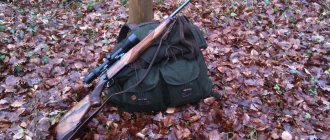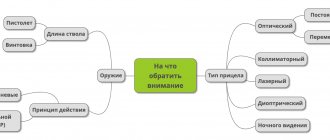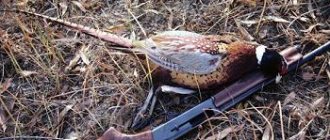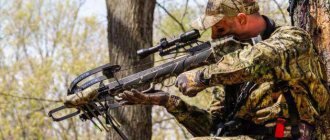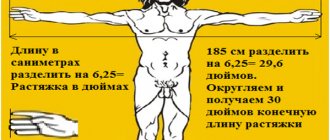Ancient Greece is fighting for primacy in the invention of the crossbow, where the gastraphetus, a bow with a lever mechanism for tensioning the string, was known from the 5th century. BC, and China during the Han Dynasty, in which a bow of a similar design has been mentioned since the 4th century. BC. Having ultimately given way to firearms, it has not completely given up its position, and the choice of crossbow is still being made not only as a sporting or hunting weapon, but also to a limited extent in the arsenal of the armies of a number of states.
Crossbow for hunting.
What should a crossbow be for hunting?
Hunting with a crossbow, bow, muzzle-loading firearm - you can get a trophy using these methods in many regions of the world, from North America to China.
Unlike sport or recreational shooting, where conditions are quite comfortable and predictable, the hunter is in the wild, and his opponent is often a large animal.
Therefore, hunting crossbows have their own requirements. He must:
- Comply with the regulatory framework - often the law sets strict restrictions on the parameters of the weapon and the need for a license.
- Be powerful. Injuring an animal is inhumane. In addition, conditions may not allow you to get a wounded animal. Therefore, a hit should guarantee a result.
- Be precise. Of course, this requirement applies to all small arms. Low noise theoretically provides the opportunity for a second shot, but the real situation may not provide such a chance.
- Be reliable. Obviously, the weapon must remain operational after falls, impacts, and function in difficult weather conditions.
- Be attractive. When choosing from a variety of samples with approximately identical characteristics, this criterion often becomes decisive. Coloring also plays a role, since some animals distinguish between colors and the striking coloring of a weapon will be an unmasking factor.
A properly selected crossbow is the key to a successful hunt.
Optimal distance and aiming points
It is considered optimal for a crossbow to shoot at a target located at a distance of up to 50-60 meters. There is no need to worry about accuracy; the spread of this weapon is several times less than that of smoothbore guns. The shape of the arrowhead is such that when it hits, it penetrates 20 cm into the animal’s body. It affects the internal organs and simply paralyzes its motor activity. There are practically no wounded wounded animals that escape from the hunter, since there is always the opportunity to fire a second shot. The video clearly shows this process. You need to aim at the stomach, neck or chest of the animal, this is especially true for large and powerful game such as wild boar or deer.
Varieties
The action of the crossbow is based on the use of the stored energy of the elastic element (these are the shoulders, the arc), which the bowstring transfers to the thrown projectile.
Design features of the implementation of the operating principle divide crossbows into:
- Recursive.
- Block.
According to the layout diagram we can distinguish:
- Pistol type.
- Rifle type.
Domestic standards classify crossbows by arc strength (kgf):
- Universal sports and hunting - over 43 kgf.
- Match sports - no more than 80 kgf.
- Sports - up to 43 kgf.
- For recreation and entertainment - up to 43 kgf.
The first two categories relate to weapons with the corresponding regime of legal regulation of their circulation.
Recursive
This is the closest design to a classic crossbow. A distinctive feature of such a weapon is the tips of the shoulders, directed forward. They perform the function of additional levers, which allows increasing efficiency while reducing the weight and dimensions of the crossbow.
Recurve crossbows are powerful, simple and reliable. However, they also have disadvantages:
- Increased loads on the trigger mechanism.
- Low reload speed.
- Dependence of power on the length of arcs. This leads to an increase in the size of the weapon and its weight.
- Large dimensions impose restrictions on the conditions of use. The owner will experience difficulties when hunting in wooded areas.
Coyote recurve crossbow.
Block
The effectiveness of crossbows of this type is increased by using a system of blocks (pulley blocks) and eccentrics. Compared to the recursive option, this option has a number of advantages:
- Light weight and dimensions are suitable for most types of hunting.
- A small load on the trigger increases its service life.
- High boom speed and power.
- Increased rate of fire.
At the same time, block crossbows are characterized by general complexity, a labor-intensive setup procedure and low maintainability in the field.
Compound crossbow.
Pistol crossbows
Pistol form factor combined with a crossbow mechanism. Such samples are suitable for both small game hunting and fishing. Not only arrows, but also harpoons or metal balls can act as projectiles.
However, the downside of their miniature size is their relatively low power, which is why they are most often used as crossbows for recreational shooting rather than for hunting.
Pistol crossbow.
Rifle crossbows
This arrangement, externally similar to the shapes of firearms, is the main one. Wood, composites, metals and light alloys are used for manufacturing. The most powerful mechanisms are implemented on the basis of rifle crossbows.
An ergonomic stock and butt, the ability to adjust to anatomical features, and the availability of seats for various types of sights make them the most common and popular.
Rifle-type crossbow.
Advantages and disadvantages
In fact, there are quite a lot of these pros and cons, and they are both objective and subjective, but, nevertheless, we can highlight the following advantages in crossbows for hunting:
- An exciting process in which both the hunter and his prey are balanced in their chances.
- Simplicity and reliability of the shooting device itself. Crossbows for hunting, produced in modern technological production, are made of high-quality materials and perform their function flawlessly in any weather.
- The speed of the arrow's flight is so high that it does not allow the victim to evade the shot, even animals with such qualities as speed and speed of movement.
- No noise when fired, which makes it possible not to scare away all the game in the area with shots.
- Relatively low cost and reusable arrows.
At the same time, crossbows for hunting have a number of limitations:
- Inability to conduct targeted shooting at flying targets.
- Limited shot power, which does not allow hunting any animal.
- Silence. Many consider this not an advantage, but a disadvantage of this type of weapon. In the minds of these people, hunting with a bow and crossbow is nothing more than poaching.
Criterias of choice
A modern crossbow is a technically and technologically complex device. The answer to basic questions and knowledge of design features make the choice easier, saving time and resources for the future owner.
Before you begin directly choosing a crossbow for hunting, it is advisable to answer a number of primary, basic questions:
- Since you are purchasing a hunting crossbow, find out which type of crossbow the law allows for use.
- What type of hunting is expected (with approach, from ambush) and what kind of animal is hunting with a crossbow (boar, other large or small animal).
- The predominant type of terrain in hunting grounds (open steppe or closed wooded, flat or very rugged).
- Your own physical capabilities are, first of all, indicators of endurance and muscular strength.
- It is important to understand the fact that the very principle of operation of a crossbow is based on mechanical force, so it can be destroyed and injure the owner. Leading manufacturing companies can ensure high quality products and materials, which reduces the risk of such situations occurring. The downside is the high cost of their products.
It is also necessary to take into account the technical characteristics, which will be discussed below.
Power
As a rule, for hunting small game, the power of a crossbow is 43-47 kg. Hunting for a large animal will require a power of at least 60 kg.
Hunting for wild boar with a crossbow.
Weight
Not only carrying, but also shooting heavy weapons is fraught with difficulties. This applies even more so to running hunting. Physical fatigue, in addition to the general deterioration of the owner’s condition, is a prerequisite for a miss.
Dimensions
Hunting in wooded areas with large weapons creates difficulties when moving or approaching the animal.
Hunting elk with a crossbow.
Material
Not only the price of the product, but also its performance characteristics depends on it. For example, aluminum will be somewhat cheaper than composite, but will create discomfort when used in winter.
Presence and orientation of fuse
It is positioned according to the “right-handed/left-handed” principle. Neglecting this criterion will not only create inconvenience when shooting, but can also lead to injury to the owner.
Weaver plank
This is a type of rail-bracket that is used for mounting various sights, flashlights, target designators and other additional equipment on weapons. Its presence significantly expands the capabilities of the crossbow. As a rule, it is included in the basic package.
There is another standard - Picatinny rail . Both brackets differ from each other in the size of the seats. It will be useful for the user to know this nuance - equipment designed for installation on a Weaver rail is compatible with a Picatinny rail, but not vice versa.
Blank shot protection
A mandatory and important part of the trigger mechanism. Unlike firearms, a dry shot from a crossbow will most likely lead to the destruction of the arms and its complete failure. This phenomenon is especially dangerous for a block crossbow. The function can be implemented automatically. Some models do not have such a mechanism and this, of course, is not a good choice.
Crossbow Scout.
Price
Of course, belonging to a brand increases the cost, but does not always guarantee high consumer qualities. Mindlessly focusing on a well-known name is not the best solution.
However, choosing branded products has its advantages:
- Stability of quality.
- Use of proven materials.
- Warranty and post-warranty service.
- Wide selection of additional equipment, spare parts and components.
Powerful pistol crossbow.
Ammunition for crossbow shooting
Here we return again to the question of what animal we are going to hunt. If the animal is large (boar, roe deer, deer, etc.), then the best choice would be carbon or fiberglass bows or arrows. This arrow is reliable, durable and superbly balanced. For hare and bird hunting, as well as for fun, cheaper aluminum arrows are quite suitable. The crossbow arrowhead is equipped with 3 or more harpoon-type blades. There are designs that provide for changing individual blades, which can be clearly seen in the video. There are special arrows for hunting fish - their tip is made in the form of a spear. If you wish, you can save a lot on purchasing arrows. There are universal ammunition on sale that can be used for both hunting and training. They have a thread on the shaft, which allows you to quickly replace the sporting tip with a hunting one. Plumage. The quality of stabilization of the arrow in flight, and, consequently, the accuracy of shooting depends on this important element. Hunting arrows have long fletching, which speeds up the stabilization of the arrow, which is especially important when shooting at short distances. To hunt a hare or bird, arrows with a length of about 30 centimeters and a weight of about 25 grams will be sufficient. To hit a wild boar or other large prey, you will need arrows 50 centimeters long and weighing 30-35 grams.
How to use a crossbow correctly
A crossbow, like any other technical device or mechanism, requires the most general and usual procedure after acquisition:
- Studying the instructions and operating rules.
- Assembly.
- Settings.
At each of these stages, the user has the opportunity to contact the manufacturer or seller for help.
Of course, shooting is necessary. Specialized shooting clubs will provide a platform and advice. It is advisable to take a training course there, since shooting from a crossbow differs from shooting from a firearm.
But the most important thing is to follow safety rules. Proper use means safe use. The requirements specific to a crossbow include:
- Prohibition on actions that could lead to a blank shot.
- Prohibition of using arrows that are too light or heavy.
- Control of the position of the fingers on the stock.
- Control of the position of the arc relative to surrounding objects.
Since the breakdown of a crossbow often leads to serious injuries, a number of rules are aimed at preventing such actions.
A significant part of the rules is devoted to preventing accidents when hunting with a crossbow.
The safety rules that apply to firearms also apply to throwing weapons:
- Prohibition on pointing a crossbow towards people and animals.
- It is mandatory to treat an unloaded weapon as if it were loaded.
- The requirement to remove the weapon from the safety lock immediately before shooting.
Sight selection
In the “man-weapon” system, accuracy is ensured not only by the skills of the shooter, but also by the characteristics of the weapon itself. The main role in this is played by the sight.
All types of sights used by crossbows are divided into three groups, each of which has its own advantages and disadvantages.
Mechanical (dioptric)
Simple sighting devices consisting of a front sight and rear sight (diopter). The advantages include speed of aiming and versatility. The disadvantage is that it requires the owner's shooting skills. At the moment, mechanical sights are being replaced by two other types.
Collimator
Collimator sight.
The operating principle is based on the effect of reflection of a light beam. The aiming process consists of aligning the aiming mark with the target. Such sights are optimally used at firing ranges of up to 30 m, they are characterized by high aiming speed, are effective in the twilight, but require specific skills - aiming is carried out with two eyes.
In addition, red dot sights are dependent on power sources that quickly discharge at low temperatures, and are also less accurate than optical ones.
Optical
Optical sight.
The main advantage of such sights is the ability to shoot accurately over long distances. They are also not without their drawbacks: high-power optics are sensitive to hand shake and have a narrow angle of view. In addition, all optical sights reduce the intensity of the light flux and are difficult to use at dusk.
As a rule, preference is given to scopes with variable magnification from 2x to 4x, combining a wide angle of view with sufficient magnification and tolerance for hand tremors.
The choice of scope depends, first of all, on hunting conditions and the type of crossbow. Obviously, installing even a light universal optical sight on a pistol-type crossbow will often be unnecessary, and a powerful optical sight will create inconvenience during hunting due to its significant mass.
Almost all crossbows are equipped with one of the types of brackets: Weaver or Picatinny rails, or a dovetail mount. The first two types provide better accuracy due to the higher rigidity of the sight mount.
Ammo selection
Modern crossbows use four types of ammunition:
- Arrows. They are the main crossbow ammunition. They differ in length and the presence of plumage of three feathers. For the convenience of the user, one of them, intended for placement in the gutter, is painted a different color from the other feathers. Arrows, as a rule, are made of carbon fiber and have a mass not exceeding 35 grams. Some crossbow arrows reach a length of 67 cm and are not much different from bow arrows. Due to their small mass, arrows are used for hunting small game.
- Dart. They are shorter (up to 40 cm) and heavier (over 40 grams) ammunition designed for hunting large game.
- Harpoons. They differ from arrows in the absence of feathers and the presence of an attachment for a line. As the name suggests, they are designed for fishing.
- Steel balls . They are used in crossbows intended for recreational shooting and are not considered as hunting projectiles.
Crossbow for hunting.
Types of tips in the photo
Hunting Broadheads Broadheads Expanding Tips
They are also reusable, and the bright color allows them not to be lost in the forest. The tips of hunting arrows have a special design - 2 or 3 blades placed at an angle to each other. The fletching is longer than that of sports ones, which stabilizes the arrow well at different distances, even closer than 30 meters. The average length is 30–40 cm, weight 30–35 g. Arrows for small game and birds are shorter and lighter: up to 30 cm, weighing up to 35 g.
All modern crossbows are equipped with a dovetail mount that can be used to mount an optic. According to reviews from crossbow owners, the best option is 4x24 or 4x32 optical sights. Even preferable is a collimator sight. It allows you to aim at twilight and at a moving target.
Top 5 best crossbows for hunting
The popularity of certain models is not always due to their high technical characteristics. Often, users decide which crossbow to choose, guided by the combination or predominance of any product qualities. In this case, neither cost nor novelty play a noticeable role.
Aspid
A compact, inexpensive pistol-type crossbow that can fire any type of ammunition. Its power provides a firing range of up to 50. However, the lethality of a light projectile reduces it by half. It is highly accurate. Suitable for hunting small game, it works well as a crossbow for fishing.
- The view is block.
Aspid crossbow. - Weight 900 gr.
- Length 29 cm.
- Materials—metal alloys, composite.
- The actual firing range is 20 m.
- Projectile speed up to 50 m/s.
Barnett ghost 400
An accurate, safe, professional crossbow equipped with an optical sight, which has been one of the market leaders for several years.
- The view is block.
Barnett ghost 400 crossbow. - Weight 3.5 kg.
- Length 60 cm.
- Materials: composite.
- The actual firing range is 70 m.
- Projectile speed up to 122 m/s.
Carbon express cover cx2
One of the best universal crossbows.
- The view is block.
- Weight 3 kg.
- Length 92 cm.
- Materials: aluminum, carbon, composite.
- Actual firing range 60 m.
- Projectile speed up to 118 m/s.
Crossbow Carbon express covert cx2.
Parker stingray
Crossbow for catching large fish and hunting waterfowl.
- The view is block. Parker stingray.
- Weight 3 kg.
- Length 60 cm.
- Materials—composite, aluminum, carbon.
- The actual firing range is 50 m.
Tactician
A universal crossbow that uses metal balls and arrows as ammunition. Suitable for hunting both small and medium game. It is an undisputed leader in its price category.
- The view is block.
- Weight 4.3 kg.
- Length 90 cm.
- Materials: aluminum.
- The actual firing range is 80 m.
Crossbow Tactic.
Video review of Barnett Crossbows Ghost 410
Second place can be shared between the Interloper crossbow – Skald and Tactic models (Russia).
Crossbows Interloper Tactician and Interloper Skald
The third is Barnett Vengeance Crossbow (USA), specially created for Russian consumers
Barnett Vengeance Crossbow
In the premium segment, the best crossbows are TEN POINT.
Crossbow Interloper Scorpio, wooden version 4,800 rubles





